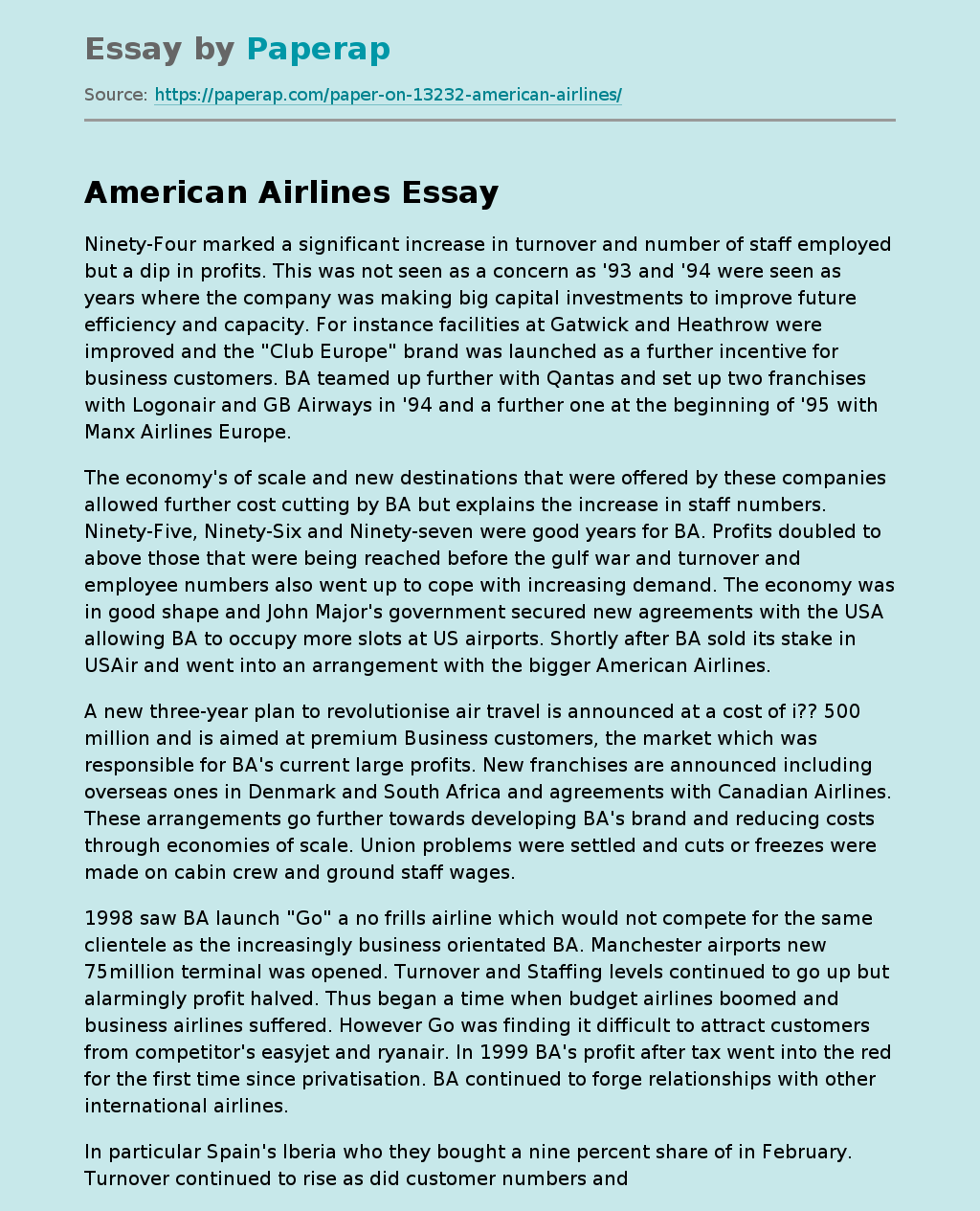American Airlines UPS and Downs
Ninety-Four marked a significant increase in turnover and number of staff employed but a dip in profits. This was not seen as a concern as ’93 and ’94 were seen as years where the company was making big capital investments to improve future efficiency and capacity. For instance facilities at Gatwick and Heathrow were improved and the “Club Europe” brand was launched as a further incentive for business customers. BA teamed up further with Qantas and set up two franchises with Logonair and GB Airways in ’94 and a further one at the beginning of ’95 with Manx Airlines Europe.
The economy’s of scale and new destinations that were offered by these companies allowed further cost cutting by BA but explains the increase in staff numbers. Ninety-Five, Ninety-Six and Ninety-seven were good years for BA. Profits doubled to above those that were being reached before the gulf war and turnover and employee numbers also went up to cope with increasing demand. The economy was in good shape and John Major’s government secured new agreements with the USA allowing BA to occupy more slots at US airports.
Shortly after BA sold its stake in USAir and went into an arrangement with the bigger American Airlines.
A new three-year plan to revolutionise air travel is announced at a cost of i?? 500 million and is aimed at premium Business customers, the market which was responsible for BA’s current large profits. New franchises are announced including overseas ones in Denmark and South Africa and agreements with Canadian Airlines.
These arrangements go further towards developing BA’s brand and reducing costs through economies of scale. Union problems were settled and cuts or freezes were made on cabin crew and ground staff wages.
1998 saw BA launch “Go” a no frills airline which would not compete for the same clientele as the increasingly business orientated BA. Manchester airports new 75million terminal was opened. Turnover and Staffing levels continued to go up but alarmingly profit halved. Thus began a time when budget airlines boomed and business airlines suffered. However Go was finding it difficult to attract customers from competitor’s easyjet and ryanair. In 1999 BA’s profit after tax went into the red for the first time since privatisation. BA continued to forge relationships with other international airlines.
In particular Spain’s Iberia who they bought a nine percent share of in February. Turnover continued to rise as did customer numbers and staff levels. The failure of Go, was a contributing factor to BA’s “worst result since 1982” (BA Reports and Accounts, 1999-2000, inside cover). In 1999, profits had taken a dramatic decline, with operating profit falling by 100 358m, down to 100 84m. Gross profit had also fallen by 100 358m, down to 100 261m. This fall in profits also had a negative impact upon investment in the company, with capital and reserves falling (BA Reports and Accounts, 1999-2000).
These dramatic falls in profitability were caused by increased competition in the market, which led to competitive pricing and marketing. British Airway’s funds were getting used too quickly. The increase in oil prices also meant increased expenditure for BA. Things got worse for BA, with low employee morale, leading to poor customer service, which in turn deeply impacted upon BA’s reputation (BA Reports and Accounts, 1999-2000). 2000 saw some return to form for the ailing BA. Turnover, Profits and Capital increased and cuts in staff were announced to try to curb the effects of the worldwide recession which seemed imminent.
The figures for 2000, were an improvement, but were not back up to pre-1999 levels. One of the major reasons for this was the foot and mouth epidemic, which hit Britain in February 2000. This stopped a lot of people from traveling both out of but especially into the UK and badly hit BA. Also the petrol crisis boosted BA’s expenses, and scared people into not traveling (bbc. co. uk). The grounding of Concorde after the Paris crash on July 25th badly hit the travel industry. It hit BA’s upper and luxury class services including the business sector that they had been so carefully nurturing.
In all this time of hardship, passenger traffic fell by more than 13% (telegraph. co. uk). 2001 looked promising; In May the airline reported a sharp rise in profits and revealed that it was making more money from each customer than it has done since it was privatised in 1987. The new chief executive, Rod Eddington, was being congratulated for turning BA around after years in the wilderness with former boss Bob Ayling. (news. bbc. co. uk/). He planned to stay true to the formula of concentrating on the premium business sector and so in June 2000 completed the sale of Go, BA’s no-frills airline, making a 75m profit from its initial investment three years ago.
Then, unbelievably the events of September the 11th occurred and within 2 weeks BA were announcing job cuts of over 7000, profit warnings were issued and competitors were going bust. Passengers were unwilling to fly due to safety concerns and the whole industry was hit hard. Suddenly the safety issue that had not grabbed the headlines for 10 years is again a priority and the mountain that BA had climbed since the Gulf War is bigger than ever. BA posted huge losses in 2001 with analysts predicting that it will take several years for the industry to begin to recover.
American Airlines UPS and Downs. (2018, Jan 23). Retrieved from https://paperap.com/paper-on-13232-american-airlines/

